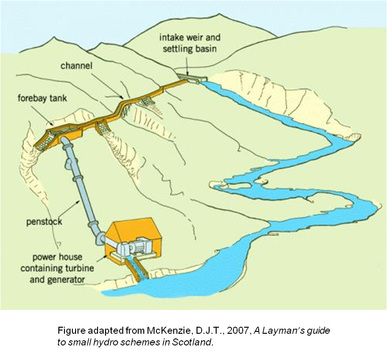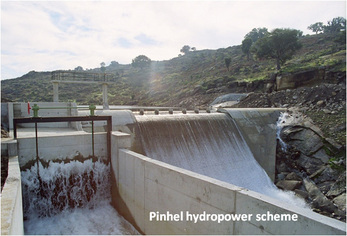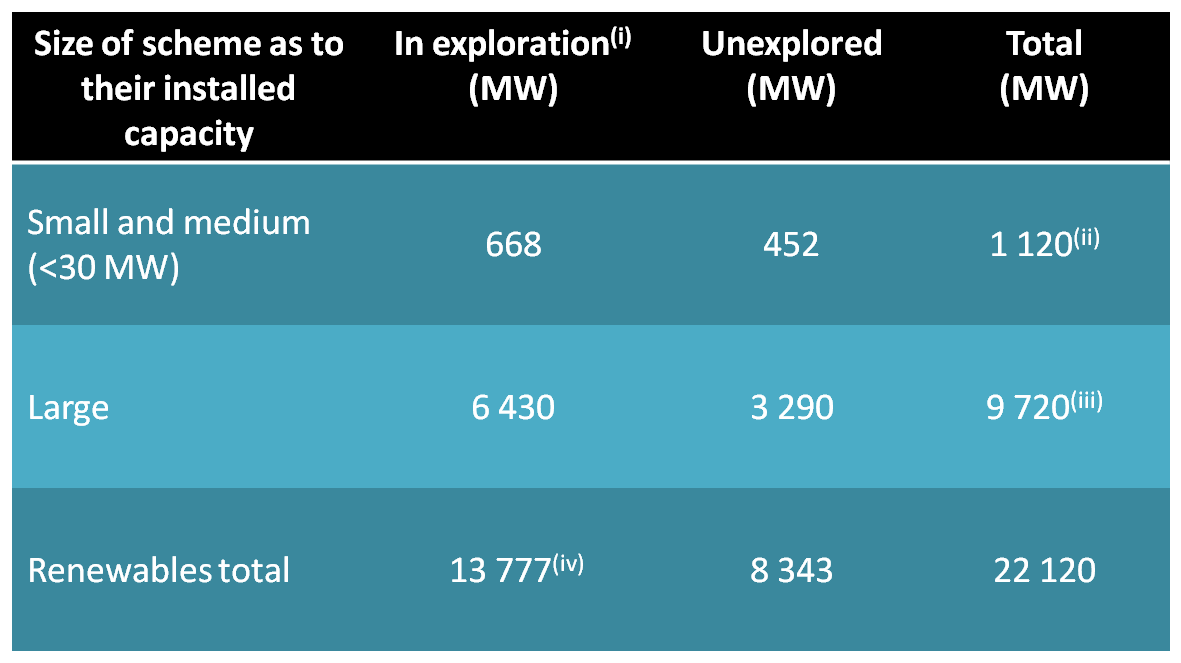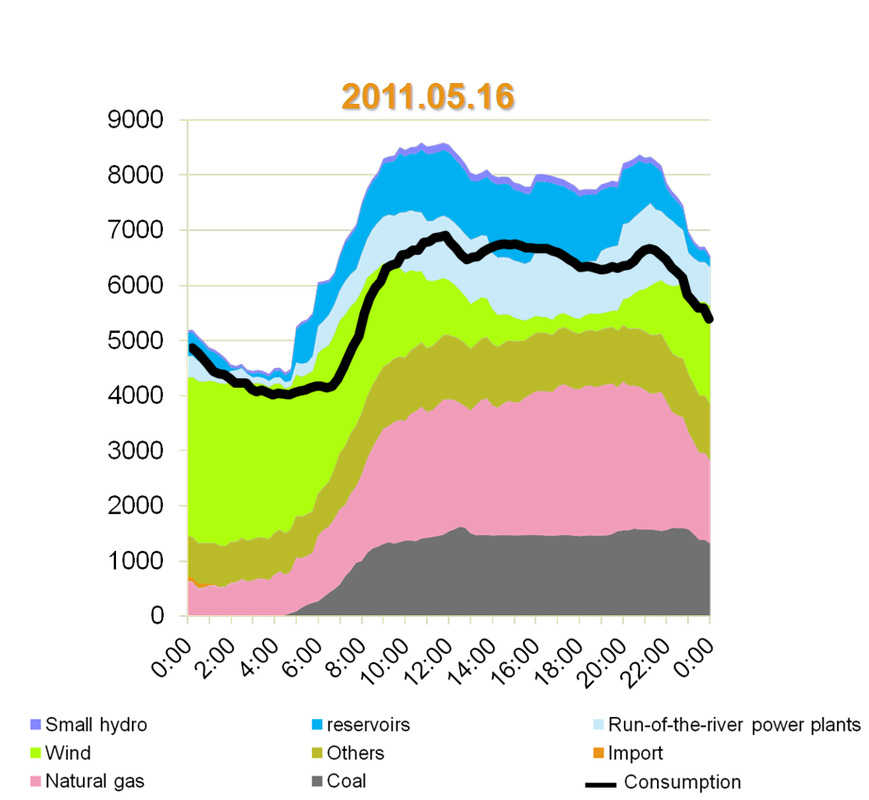Overview of the renewable resource
Historical use
Kinetic energy of water was used centuries ago through mechanical work. In fact, the main components of watermills were developed more than 300 years before the Christian era.
In Portugal, the use of water as a driving force has also been made for centuries, through the traditional watermills. As far as electricity generation is concerned, namely to feed small public lighting and industrial facilities, the use of water, through turbine-generator units, started in the last decade of the nineteenth century.
The first Portuguese hydropower plant using what was then called the “white coal” came into operation on 31st March 1894. It diverted the water from the Corgo River, on Poço do Aguieirinho, near the city of Vila Real, and had the small installed capacity of 120 kW (161 Hp, as it was said back then).
The effective electrification of the Country started in 1920, through regional systems and medium-sized hydropower plants (Lindoso, with 28 MW, being at the time the most relevant one). It then gained significant importance in the 1950s with the construction of the first large hydropower plants, of which some of the most relevant ones are Venda Nova, Castelo do Bode, Cabril, Picote and Miranda. The total installed capacity in large hydropower plants presently exceeds 6000 MW.
The number of small hydropower plants (SHP), with installed capacities of 10 MW or less, grew considerably in the late 1980s, with the emergence of the newly created private power producers. The capacity presently installed in SHP is around 370 MW.
In Portugal, the use of water as a driving force has also been made for centuries, through the traditional watermills. As far as electricity generation is concerned, namely to feed small public lighting and industrial facilities, the use of water, through turbine-generator units, started in the last decade of the nineteenth century.
The first Portuguese hydropower plant using what was then called the “white coal” came into operation on 31st March 1894. It diverted the water from the Corgo River, on Poço do Aguieirinho, near the city of Vila Real, and had the small installed capacity of 120 kW (161 Hp, as it was said back then).
The effective electrification of the Country started in 1920, through regional systems and medium-sized hydropower plants (Lindoso, with 28 MW, being at the time the most relevant one). It then gained significant importance in the 1950s with the construction of the first large hydropower plants, of which some of the most relevant ones are Venda Nova, Castelo do Bode, Cabril, Picote and Miranda. The total installed capacity in large hydropower plants presently exceeds 6000 MW.
The number of small hydropower plants (SHP), with installed capacities of 10 MW or less, grew considerably in the late 1980s, with the emergence of the newly created private power producers. The capacity presently installed in SHP is around 370 MW.
Overall design of hydropower schemes

Hydropower uses the flows and the elevation drops available in a certain river reach. The energy production potential is then directly related to the land orography, that creates the necessary heads, and to the available surface water resources, which, in turn, determine the flow volumes to be led to the turbine.
As a result of the geographical variability of the hydropower production potential (that is dependent on the available flows and heads), small hydropower schemes are heterogeneously distributed through mainland Portugal, with 95% of the installed capacity being located from the Mondego river basin up North. It is also in the North of the Country that the greatest potential for the construction of new hydropower schemes may be found.
Hydropower plants are mostly located on rivers, and they may be associated to dams with water storage capacity, generally of medium and large size, or to weirs without water storage capacity and harnessing the energy of seasonal river flows (run-of-river operation).
Small hydropower plants may have different layouts that are meant to optimize, in each site, the relationship between divertible flow for the turbine operation and the available head. The Figure hereunder is a schematic layout of one of the most common small hydropower schemes located on rivers in the North of Portugal, in their upper reaches where the greatest elevation drops are found.
As a result of the geographical variability of the hydropower production potential (that is dependent on the available flows and heads), small hydropower schemes are heterogeneously distributed through mainland Portugal, with 95% of the installed capacity being located from the Mondego river basin up North. It is also in the North of the Country that the greatest potential for the construction of new hydropower schemes may be found.
Hydropower plants are mostly located on rivers, and they may be associated to dams with water storage capacity, generally of medium and large size, or to weirs without water storage capacity and harnessing the energy of seasonal river flows (run-of-river operation).
Small hydropower plants may have different layouts that are meant to optimize, in each site, the relationship between divertible flow for the turbine operation and the available head. The Figure hereunder is a schematic layout of one of the most common small hydropower schemes located on rivers in the North of Portugal, in their upper reaches where the greatest elevation drops are found.
Current situation and development outlook of hydropower in Portugal
Advantages of hydropower
- it’s a renewable energy source, available in the Portuguese watercourses.
- it´s a clean energy source that does not produce greenhouse gases or other pollutant agents (ashes, radioactive material, other residues).
- it helps reducing the external energy dependence, through lower fossil fuel imports (oil, natural gas and coal).
- it helps to avoid, per each MWh of hydroelectric energy generated, the emission of 0.37 tonnes of greenhouse gases that would otherwise result from the use of fossil fuels.
- it helps Portugal fulfilling the commitments undertaken, and achieving the targets set at international level, namely in the Kyoto Protocol, in the Paris Agreement and in European Community legislation (Directive 2009/28/CE and the agreement established in July of 2018 for the objectives Energy Climate 2030).
- it complements other forms of electricity production, thus contributing to diversify and disseminate the means of production.
- it promotes the creation of employment, both during the construction phase and during the operation and maintenance phase, and the creation of new infrastructures.
- it assures the stabilization of the energy fed into the electricity grid, enabling a quick response to peak demands and to substantial breaks in other forms of energy production (as shown in the following energy production/consumption diagram).





